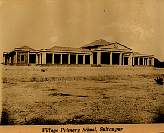Education
The
highest problem for a State is that of education of its people. It
may ensure their safety by ever vigilant protection and their
material prosperity by wise agricultural or fore-sighted trade
policy, but without proper education these at their very best would
make them little more than a mere community of healthy well-fed
animals.
His
Highness being a scholar and an educationist himself has all along
been conscious that it is education with its resulting culture which
breathes the soul in the various activities of a State, and
consequently maintains his Education Department at a very high cost
never grudging the money that he spends on it.
|

Education
chart
1884 to 1932
|
|
|
|
Schools
H.
H. believes that architectural strength with its necessary
concomitant sanitary make-up plays an important part in the
formation of school atmospherics, enhances aesthetic ideas and
stabilizes sanitary principles. With this in view and under a large
civilizing program of providing educational facilities at the very
door of each and every subject of the state, type plans of village
schools have been prepared and for towns, capacious buildings
marking the individuality of each town are being constructed.
Under the program, even the smallest village will have a primary
school costing about Rs. 10,000.
At Sultanpur, Khokhri and Paneli, villages with populations ranging
from 2000 to 4000 persons, vernacular schools containing 11 rooms
with a central hall costing about Rs. 90,000 have been constructed,
and according to the program every village containing the above
population is going to get the same type of the school building.
The
scheme of introducing gardening in every school has been successful
and nice gardens have been seen to be attached to them. Many of the
schools have gained the Shree Bhagvatsinhjee gold and silver medals
for agriculture.
|

Birendrasin
Bal-mandir Upleta
|
|
|
|

Village
School (One Unit)
|
|
|
|

Primary
School (Sultanpur)
|
|
|
|

Paneli Primary School
|
|
|

Chart
of education between 1900 to 1932
|
|
|
|

Taluka
School
|
|
|
|
|

Gujrati
School Upleta
|
|
|
|
|
|
|